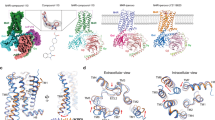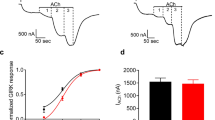Abstract
ANTIPSYCHOTIC drugs (for example, phenothiazines, butyrophenones) have side effects similar to those of atropine1, suggesting that they block the muscarinic acetylcholine receptor. Receptor-binding studies with radioactively-labelled ligands have been used to study the muscarinic acetylcholine receptor and to show that antipsychotic drugs vary in their potency at displacing the ligand from binding sites in rat brain homogenates2,3. In all receptor binding studies it is essential to demonstrate that binding data in fact reflect a drug-receptor interaction in a pharmacological sense4. These correlations are ideally determined using the same tissue for binding and for biological studies such as was done for certain polypeptide hormone receptors4 and for the β-adrenergic receptor5. For the muscarinic acetylcholine receptor of nervous tissue, however, a direct correlation of binding data with pharmacological data has not been shown6. Thus, there remains a question whether the displacement by antipsychotic drugs of a radioactively-labelled muscarinic receptor antagonist from brain homogenates reflects blockade by these drugs of this receptor. We report here that antipsychotic drugs block the muscarinic acetylcholine receptor in cultured nerve cells.
This is a preview of subscription content, access via your institution
Access options
Subscribe to this journal
Receive 51 print issues and online access
$199.00 per year
only $3.90 per issue
Buy this article
- Purchase on Springer Link
- Instant access to full article PDF
Prices may be subject to local taxes which are calculated during checkout
Similar content being viewed by others
References
Shader, R. I. & DiMascio, A. Psychotropic Drug Side Effects (Williams and Wilkins, Baltimore 1970).
Snyder, S. H., Greenberg, D. & Yamamura, H. I. Archs gen. Psychiatr. 31, 58–61, 1974.
Miller, R. J. & Hiley, C. R. Nature 248, 596–597, 1974.
Hollenberg, M. D. & Cuatrecasas, P. in Handbook of Psychopharmacology 2 (eds Iversen, L. L., Iversen, S. D. & Snyder, S. H.) 129–177 (Plenum New York, 1975).
Mukherjee, C., Caron, M. G., Mullikin, D. & Lefkowitz, R. J. Molec. Pharmac. 12, 16–31 (1976).
Snyder, S., H., Chang, K. J., Kuhar, M. J. & Yamamura, H. I. Fedn Proc. 34, 1915–1921 (1975).
Richelson, E. in Metabolic Compartmentation and Neurotransmission (eds Berl, S., Clarke, D. D. & Schneider, D.) 305–326 (Plenum, New York, 1975).
Donnelly, C. H., Richelson, E. & Murphy, D. L. Biochem. Pharmac. 25, 1639–1643 (1976).
Fujimoto, M., Mihara, S., Okabayashi, T., Sugase, T. & Tarui, S. J. Biochem. 78, 131–137 (1975).
Matsuzawa, H. & Nirenberg, M. Proc. natn. Acad. Sci. U.S.A. 72, 3472–3476 (1975).
Greengard, P. Nature 260, 101–108 (1976).
Lowry, O., Rosebrough, N. J., Farr, L. & Randall, R. J. J. biol. Chem. 193, 265–275, (1951).
Waud, D. R. Pharmac. Rev. 20, 49–88 (1968).
Paton, W. D. M. Molecular Properties of Drug Receptors (eds Porter, R. & O'Connor, M.) 3–30 (Churchill, London, 1970).
Author information
Authors and Affiliations
Rights and permissions
About this article
Cite this article
RICHELSON, E. Antipsychotics block muscarinic acetylcholine receptor-mediated cyclic GMP formation in cultured mouse neuroblastoma cells. Nature 266, 371–373 (1977). https://doi.org/10.1038/266371a0
Received:
Accepted:
Issue Date:
DOI: https://doi.org/10.1038/266371a0
This article is cited by
Comments
By submitting a comment you agree to abide by our Terms and Community Guidelines. If you find something abusive or that does not comply with our terms or guidelines please flag it as inappropriate.



